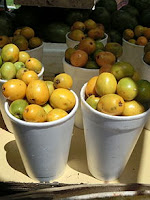Once upon a time there was a cocuyo beetle (glowing click beetle) who set out to visit some relatives. He made the appropriate preparations, prayers and invocations for safe travel, and began his journey. One time along the way, night found him on a hill, where he found the house of a zarzamora. He asked for shelter for the night, and she invited him in. She was old, leafless and bent, with some very ugly features, but she was a great hostess. She offered food and drinks, hung a hammock for him, they had a nice conversation - and the zarzamora fell in love with the beetle. The cocuyo, however, wanted nothing from her; he told her she was old and ugly, and the next morning, he went on his way.
The beetle reached his destination, visited with his relatives for a while, and then set out on the journey home. On the way back, he happened to stop on the same hill where the zarzamora lived. Surprise! She was completely changed now: She stood straight, rejuvenated, with fresh leaves and beautiful flowers. The beetle instantly fell in love with her, but she kept ignoring him. Eventually he started begging for her to at least tell him how she became young again.
"Some people passed this way, and they set fire to me. It was the fire that rejuvenated me." - responded the zarzamora. The cocuyo immediately wanted to be rejuvenated too. So, despite the zarzamora's warnings, he flew straight to the place where people were camping, and threw himself into the fire. He was badly burnt, and turned black from the smoke forever. He returned home, ashamed of himself. His descendants have the same tendencies ever since: When they see fire, they try to fly into it, and when they see zarzamora in bloom, they can't stay away from the beautiful flowers.
(The story comes from this book.)
This was the last story for this year's A to Z. Thank you all for another fun Challenge! See you in May for the Reflections. And don't forget to eat fruit!




























































